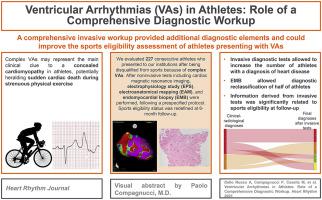Heart Rhythm ( IF 5.5 ) Pub Date : 2021-09-15 , DOI: 10.1016/j.hrthm.2021.09.013 Antonio Dello Russo 1 , Paolo Compagnucci 1 , Michela Casella 2 , Alessio Gasperetti 3 , Stefania Riva 4 , Maria Antonietta Dessanai 4 , Francesca Pizzamiglio 4 , Valentina Catto 4 , Federico Guerra 1 , Giulia Stronati 1 , Daniele Andreini 5 , Gianluca Pontone 4 , Alice Bonomi 4 , Stefania Rizzo 6 , Luigi Di Biase 7 , Alessandro Capucci 1 , Andrea Natale 8 , Cristina Basso 6 , Cesare Fiorentini 4 , Paolo Zeppilli 9 , Claudio Tondo 5

|
Background
Ventricular arrhythmias (VAs) represent a critical issue with regard to sports eligibility assessment in athletes. The ideal diagnostic evaluation of competitive and leisure-time athletes with complex VAs has not been clearly defined.
Objective
The purpose of this study was to assess the clinical implications of invasive electrophysiological assessments and endomyocardial biopsy (EMB) among athletes with VAs.
Methods
We evaluated 227 consecutive athletes who presented to our institutions after being disqualified from participating in sports because of VAs. After noninvasive tests, electrophysiological study (EPS), electroanatomic mapping (EAM), and EAM- or cardiac magnetic resonance imaging–guided EMB was performed, following a prespecified protocol. Sports eligibility status was redefined at 6-month follow-up.
Results
From our sample, 188 athletes (82.8%) underwent EAM and EPS, and 42 (15.2%) underwent EMB. A diagnosis of heart disease could be formulated in 30% of the study population (67/227; 95% confidence interval [CI] 0.24–0.36) after noninvasive tests; in 37% (83/227; 95% CI 31%–43%) after EPS and EAM; and in 45% (102/227; 95% CI 39%–51%) after EMB. In the subset of athletes undergoing EMB, invasive diagnostic workup allowed diagnostic reclassification of half of the athletes (n = 21 [50%]). Reclassification was particularly common among subjects without definitive findings after noninvasive evaluation (n = 23; 87% reclassified). History of syncope, abnormal echocardiogram, presence of late gadolinium enhancement, and abnormal EAM were linked to sports ineligibility at 6-month follow-up.
Conclusion
A comprehensive invasive workup provided additional diagnostic elements and could improve the sports eligibility assessment of athletes presenting with VAs. The extensive invasive evaluation presented could be especially helpful when noninvasive tests show unclear findings.
中文翻译:

运动员室性心律失常:综合诊断检查的作用
背景
室性心律失常 (VAs) 是运动员运动资格评估的一个关键问题。对具有复杂 VAs 的竞技和休闲运动员的理想诊断评估尚未明确定义。
客观的
本研究的目的是评估有创电生理评估和心内膜心肌活检 (EMB) 在 VA 运动员中的临床意义。
方法
我们评估了 227 名连续出现在我们机构的运动员,他们因 VA 而被取消参加体育运动的资格。在无创测试后,按照预先指定的方案进行电生理学研究 (EPS)、电解剖标测 (EAM) 和 EAM 或心脏磁共振成像引导的 EMB。在 6 个月的随访中重新定义了运动资格状态。
结果
在我们的样本中,188 名运动员(82.8%)接受了 EAM 和 EPS,42 名(15.2%)接受了 EMB。在无创测试后,30% 的研究人群(67/227;95% 置信区间 [CI] 0.24–0.36)可以诊断出心脏病;在 EPS 和 EAM 后 37% (83/227; 95% CI 31%–43%);在 EMB 后 45% (102/227; 95% CI 39%–51%)。在接受 EMB 的运动员子集中,侵入性诊断检查允许对一半运动员进行诊断重新分类(n = 21 [50%])。重新分类在无创评估后没有明确发现的受试者中特别常见(n = 23;87% 重新分类)。在 6 个月的随访中,晕厥史、超声心动图异常、晚期钆增强和 EAM 异常与运动不合格有关。
结论
全面的侵入性检查提供了额外的诊断要素,并可以改善对出现 VA 的运动员的运动资格评估。当非侵入性测试显示不明确的结果时,所提出的广泛侵入性评估可能特别有用。



























 京公网安备 11010802027423号
京公网安备 11010802027423号